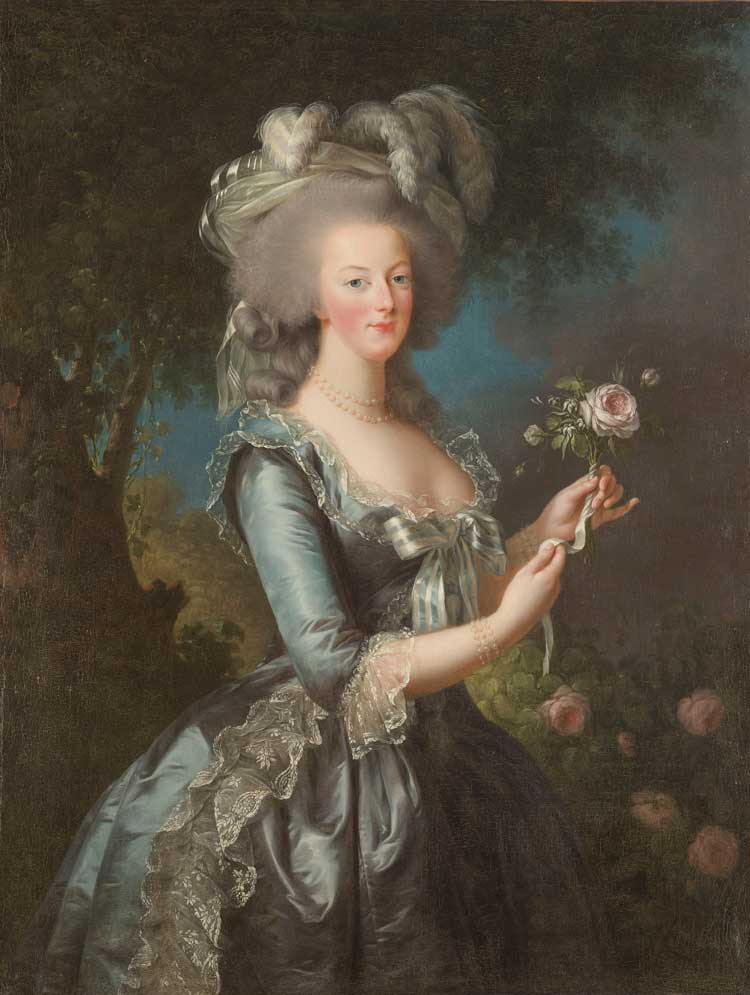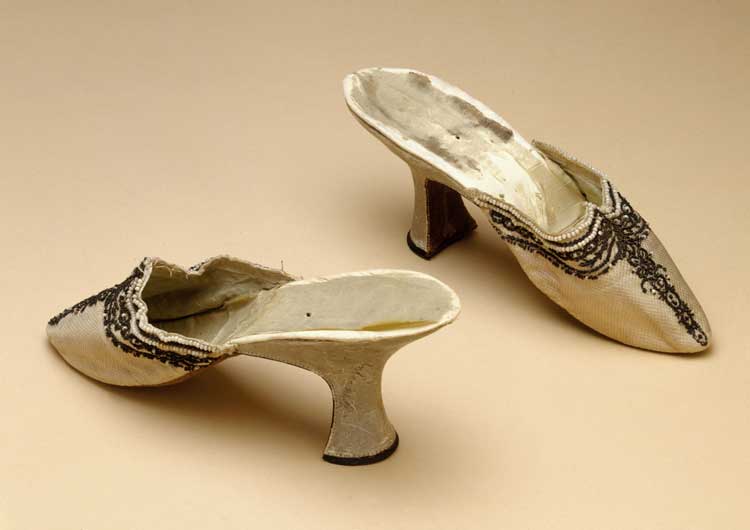-Victoria-and-Albert-Museum,-London-(21).jpg)
Marie Antoinette Style, installation view. © Victoria and Albert Museum, London.
V&A London
20 September 2025 – 22 March 2026
by CHRISTIANA SPENS
As I walk into Marie Antoinette Style at the V&A, I’m met by a looming portrait of the doomed young queen, her expression placid and distant. Around her is a vast room of dazzling dresses, jewels and little shoes, their reflections dancing across the glass cases that contain them, along with the those of visitors. Once again, Antoinette is surrounded by a mob, and as I look to see something of this enigmatic woman, I am distracted by all the passing figures, weaving in and out of her spectre. This is an exhibition about Antoinette and the things she wore, but it is just as much a reflection on us, the crowd, and the desires we have for things, particularly things we cannot have.

Elisabeth Louise Vigée Le Brun. Marie Antoinette with a Rose, 1783. Oil on canvas, 46 × 35 in (116.8 × 88.9 cm). © Château de Versailles, Dist. Grand Palais RMN / Christophe Fouin.
In the 1960s, the French philosopher René Girard published several books on desire, imitation and scapegoating. Desire, he explained, is mimetic: we desire things because others desire them first, and so all desire is in this sense contagious. As I walked over to some impressive diamonds, for instance, seeing someone else in prime position to take a good photo encouraged my own desire to take a photo, even though I did not especially need one, and not at that particular angle, either. As I walked towards busts of Antoinette that gave off different scents – a masquerade ball at Versailles, a garden, her prison cell – seeing someone else’s reaction to smelling them, even though it was one of disgust, ignited my own desire to smell them too.
-Victoria-and-Albert-Museum,-London-(12).jpg)
Marie Antoinette Style, installation view. © Victoria and Albert Museum, London.
Girard would not have been surprised. According to him, our desires are predicated on the desires of others. It is how we bond and organise ourselves; it is how we come together. But it’s a communal behaviour that inherently requires sacrifice to work. If there is not enough to go around, and there never really is, then this confluence of catching desires will inevitably lead to conflict and violence. And to resolve a conflict, amorphous social groups will find a scapegoat to absolve the sins, and desires, of the many.
-Victoria-and-Albert-Museum,-London-(20).jpg)
Marie Antoinette Style, installation view. © Victoria and Albert Museum, London.
Antoinette was a fashionable young queen, for better and worse. She came to France’s royal court an outsider, a 14-year-old Austrian girl betrothed to the Dauphin, later King Louis XVI. She used fashion to her benefit, and indeed as her main and perhaps only way to communicate with the court and the public. She made daring style choices, expressed her rising power through diamonds and dresses, and commissioned portraits by Élisabeth Vigée le Brun in an attempt to present a positive public image. She navigated her public life with careful sartorial choices, creating a persona to hide behind and wield in the theatrical world of the royal court, and yet as the years went on and the political climate changed, she faced a backlash for her decadent choices. As the Revolution stirred, she was increasingly derided by the public, used as a poster girl for the feckless aristocracy, criticised as promiscuous and self-indulgent, and nicknamed Madame Deficit. Then, with no less ceremony than her many balls and shows, she was publicly beheaded at the age of 37.
-Victoria-and-Albert-Museum,-London-(17).jpg)
Marie Antoinette Style, installation view. © Victoria and Albert Museum, London.
Girard presented Antoinette as an example of an archetypical scapegoat, epitomising the ways in which human societies elevate and discard particular people as totems. From witches to queens to political villains to bandits, the defining feature of a scapegoat is not that they are particularly good or evil, necessarily, but that they are at once a bit different, even as they are also a product of their social group. They are different enough to pick out of a crowd and then project the communal rage on to. And when the ritual has concluded, when the scapegoat has been purged, the crowd thus calmed, there is a strange reverence around that figure. “We deify our victims,” Girard wrote, and nowhere is that more obvious in this exhibition at the V&A.
-Victoria-and-Albert-Museum,-London-(14).jpg)
Left: The guillotine. Right: The white petticoat Marie Antoinette wore to the execution. Installation view, Marie Antoinette Style. © Victoria and Albert Museum, London.
From diamond-encrusted corsets to the guillotine that killed the young queen, there is something jarring about the exhibited objects of Antoinette’s life. The guillotine is terrible, of course, but it is also quite chic, presented in a room of blood-red walls next to the simple white petticoat she wore to the execution, and a quote from her from August 1793 on the wall: “Nothing can hurt me now.” Yet, her final note, also displayed here, reads of her very human pain. “16 October 1793, 4:30am. ‘My God, have pity on me! My eyes have no more tears to cry for you my poor children; adieu, adieu!’”
In the same room, there is a replica of a wax bust of the queen’s severed head, supposedly made by an unknown maker in 1907. As a note explains, this is a speculative gesture at immortalising the dead queen. “The image of Marie Antoinette’s decapitated head has continued to feed the morbid fascination with the queen. Until it was lost in a fire in 1925, [a] wax death mask which was said to have been taken on the day of her execution, was displayed at Madame Tussauds in London. Marie Tussaud watched Marie Antoinette pass through the streets on her way to the scaffold but did not witness her execution and never personally claimed to have taken her death mask, though she did create masks of other victims.”

One slipper belonging to Marie Antoinette beaded pink silk. Photo: CC0 Paris Musées / Musée Carnavalet - Histoire de Paris.
This little note, and the extremely tenuous link to the actual Antoinette, fascinates me though. Fetishised in so many ways, this tribute death mask, as it is, for me encapsulates the strange mythology of Antoinette, and the way her death has been made sacred in this perverse way. We tour around as if visiting the late queen’s tomb, as if we are a mob of grave robbers. And yet we only look and do not touch; we are absolved of any wrongdoing. And perhaps it is not wrong as such, but it is a little weird. It is also, however unsavoury, entirely human.
-Victoria-and-Albert-Museum,-London-(9).jpg)
Marie Antoinette Style, installation view. © Victoria and Albert Museum, London.
Marie Antoinette Style shows the intricate craft and artistry that went into the performance of being Antoinette, the dedicated, detailed work of many people that produced the figurehead. These are indeed beautiful things, but perhaps they are considered more so because the queen chose and commissioned them, she wore them, for some time she enlivened them with her presence. Our relationship with beautiful objects is mediated through our desire for other people, or rather other people and what they desire too. In this way, individuals forget themselves and the lines between them disintegrate; we are caught up in looking at other people and objects of mutual desire to the point where we are, without realising, a part of something bigger, a part of a mob. In this eerie but beautiful display of human ritual, Antoinette, a scapegoat for the ages, brings us all together once again, as we look to see her but see only ourselves reflected back to us in the shining glass of the display box.
-Victoria-and-Albert-Museum,-London-(3).jpg)
Marie Antoinette Style, installation view. © Victoria and Albert Museum, London.